How to Use AWS IoT Core: Your 2025 Guide
Updated: August 15, 2024
Choosing the right platform for creating and managing IoT applications in 2025 is essential for such a demanding system as the Internet of Things. Ideally, the platform should coordinate the network and sensors, support AWS IoT Core, and secure the data flow. Does it seem like we’re asking too much of it?
However, such mature IoT platforms already exist, and Amazon IoT is an excellent example. It provides such extensive functionality that you can create IoT solutions of any complexity and scale. World-famous names such as Siemens, GoPro, and Phillips have already launched their connected products with Amazon IoT Core.

We provide companies with senior tech talent and product development expertise to build world-class software. Let's talk about how we can help you.
Contact usAt Relevant Software, we value the AWS IoT platform’s convenience and adapt it to deliver IoT solutions. Dive into our introduction to AWS IoT to discover all pitfalls and perks of applying it to your business.
Table of Contents
Why use AWS IoT?
Amazon Web Services (AWS) grants a comprehensive set of cloud-managed tools that helps businesses grow and succeed. It also involves the AWS IoT platform – specially designed for the Internet of Things.
As stated by Eclipse Foundation, 51.8% of IoT developers prefer AWS IoT for developing applications. AWS IoT presents tools to enable IoT users and programmers to build, configure, and connect IoT systems.

The Amazon Web Services IoT platform is compatible with such common programming languages as C, JavaScript, Java, Python and equipped with software development kits for Android, iOS, and Arduino. In addition, it delivers opportunities for innovation (artificial intelligence, blockchain, machine learning), AWS server storage, and scalability.
Supported by Amazon’s vast cloud ecosystem, AWS IoT can efficiently process trillions of messages and route those messages reliably and securely between AWS endpoints or other devices. Moreover, AWS IoT affords software that integrates devices into IoT-based solutions.
Nowadays, every new industrial or consumer product integrates IoT functionality. Amazon, like other vendors, aims to reach all markets. Smart homes, infrastructure maintenance, industrial applications, and environmental monitoring are just a few sectors that benefit from AWS IoT deployments. Let’s check out use cases of utilizing Amazon AWS IoT:
Philips
The company successfully leverages AWS services to gather data on the condition of over 190 million patients worldwide, analyze this data, and share it with medical staff to improve diagnostics.
iRobot
This consumer robotics company takes to profit from a serverless AWS IoT Core architecture. The AWS IoT implementation helped the company to reduce maintenance costs and diminish the number of management personnel.
Bayer Crop Science
That is where AWS IoT services came in handy for precision farming. Bayer Crop Science monitors seed health at different stages by field sensors. The company analyzes this information to optimize the growing environment for increased yields.
LG Electronics
This major electronics manufacturer chose AWS IoT to reduce the time it takes to manage its IoT platform. In addition, AWS is the only cloud provider whose IoT services meet the LG ThinQ platform support demands.
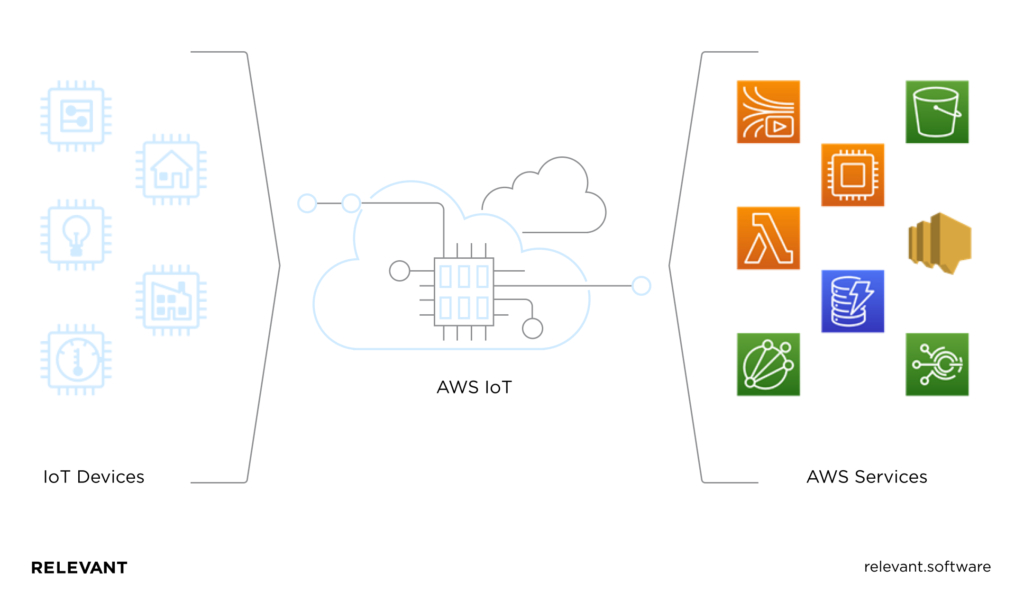
AWS IoT benefits for your business
Reliability and performance, coupled with IoT data collection capacities, are not the only reasons for integrating AWS with your IoT project. There are others, no less crucial:
Serverless architecture
The serverless approach lowers the cost of MVP and prototyping and increases the flexibility of the entire IoT application development process. Developers can concentrate on core tasks without worrying about maintaining server stuff.
Robust analytics
Amazon introduces a range of powerful analytics tools for analyzing data across the IoT ecosystem. They turn raw data into valuable material for calculations, use various analytics and visualization methods to extract information, and prepare them for machine learning.
High-security standards
IoT security matters, which is why Amazon carefully protects all devices, communications, and customer data. AWS implements a strong authorization, authentication, and encryption level to ensure communications security between the IoT platform and joined devices.
Extensive partner network
Amazon actively partners with numerous IoT software vendors and device manufacturers. This way, you can be sure that hardware compatibility will not severely constrain your IoT apps.
Integration with AWS products and services
The AWS IoT permits developers to connect IoT devices and leverage other Amazon web services. That is convenient because you don’t have to switch to another service to add an extra feature.
Flexible pricing
Amazon proposes a friendly pricing model – you pay for what you utilize. Amazon IoT core pricing is based on connection time, message count, registered devices, and more. There are no default service charges or upfront charges.
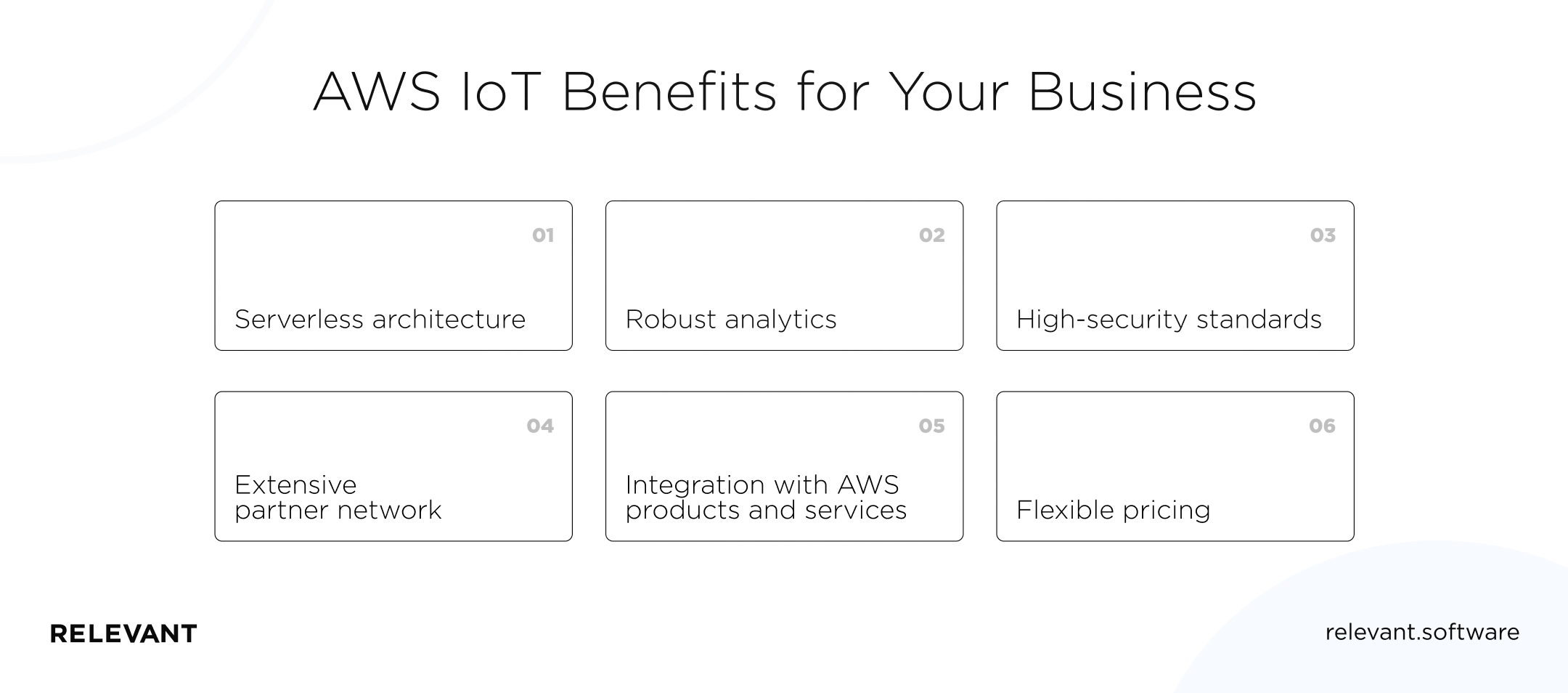
What are the AWS IoT services?
Amazon’s platform solves all the problems associated with IoT products and services. That allows enterprises to deliver commercial, industrial, and customer IoT solutions without disrupting infrastructure management. AWS IoT services fall into three categories:
Device software
This category comprises software for connecting and controlling IoT devices at the periphery.
FreeRTOS
This operating system simplifies the programming, deployment, connection, and protection of low-power peripherals (sensors, trackers, etc.). It offers substantial software libraries to link simple devices to more powerful ones on edge and in the cloud.
AWS IoT Greengrass
The service enables peripherals to work locally with the data they create while using the cloud to manage, analyze, and securely store data. AWS IoT Greengrass runs on a wide range of devices, from server-side to Raspberry Pi.
Connectivity and control services
The platform also offers tools for monitoring and maintaining the health and safety of a fleet of devices.
AWS IoT Core
That is an underlying Amazon and IoT service that attaches all connected devices to the Amazon cloud. It is robust enough to handle myriads of device connections and reliably secure messaging and data exchange. If needed, Amazon IoT Core can extend the functionality of your IoT system with extra services like AWS Lambda.
AWS IoT Device Defender
This service guards the devices against tampering or misuse through identification, authentication and authorization, and data encryption. You can configure alerts and report suspicious behavior such as DDoS attacks from a device.
AWS IoT Device Management
This service registers, monitors, and manages connected IoT devices at any scale through a web application. AWS IoT Device Management is device-independent and OS-agnostic, so you can use it to control anything from connected cars to microcontrollers in other systems.
Analytics services
Amazon IoT eliminates infrastructure requirements by providing an infrastructure-as-a-service solution for enterprises to process and analyze IoT data.
AWS IoT Analytics
It is a wholly managed service that filters, modify, and enriches streaming IoT data in real-time. It accumulates data in a data warehouse for analysis using the built-in SQL query engine and performs sophisticated analytics such as machine learning inference.
AWS IoT Site Wise
With this AWS solution, you can simplify the gathering and routing multi-format sensor data from equipment scattered over large manufacturing or industrial sites. This service assists you in organizing, managing, and carrying out performance metrics locally by affording software and other on-site computing devices.
AWS IoT Things Graph
That service presents a graphical interface for configuring interactions between web services and devices, enabling you to raise low-power applications swiftly. Devices and services are represented using models – ready-made, reusable components. Models hide basic-level characteristics such as protocols and interfaces and allow easily integrated features in complicated workflows.
AWS IoT Events
This IoT service lets you detect events from sensors and IoT applications and take pre-defined actions before loss or failure occurs. Events are data templates that identify specific circumstances, such as changes to equipment when a belt gets stuck or motion detectors that use motion signals to turn on lights and security cameras.
These are just a few examples of many AWS IoT solutions and products. You can find an extensive pool of software on AWS’s marketplace for other uses as well.
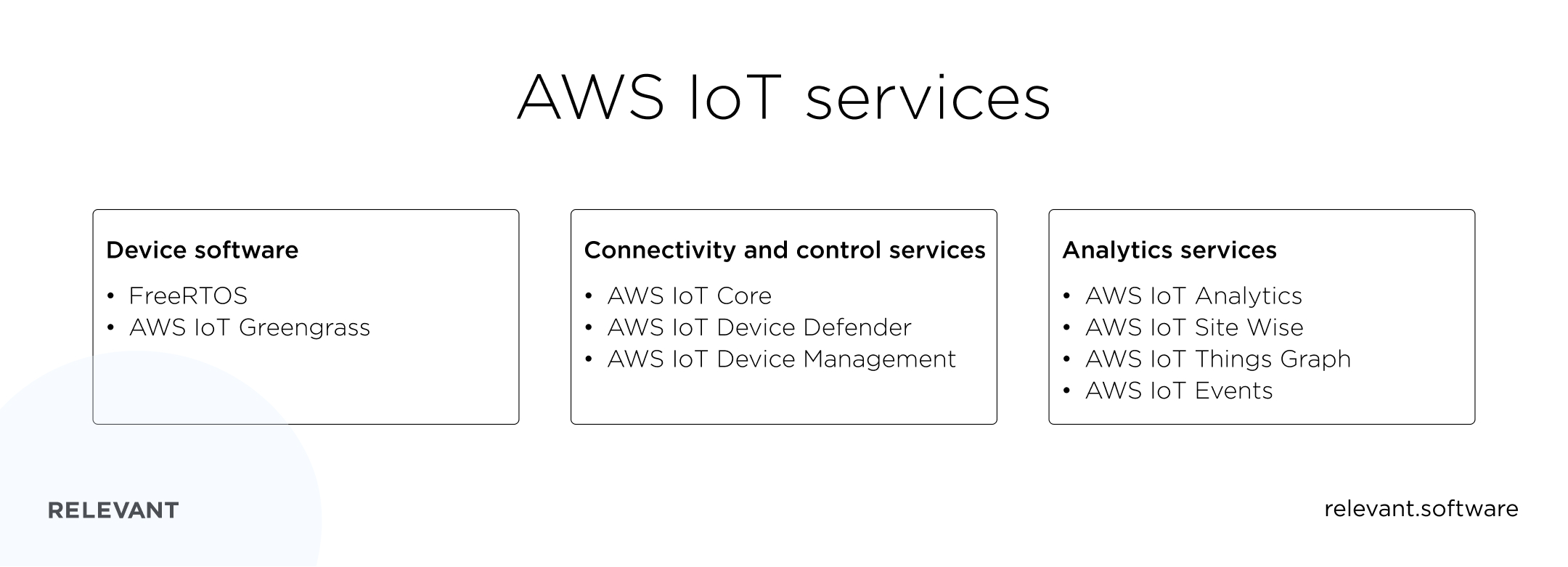
What is AWS IoT Core?
AWS is positioning the IoT Core as the “base for IoT deployment,” as it represents all the infrastructure you need to build and run your IoT projects.
The definition of AWS IoT Core
AWS IoT Core is a specialized, feature-rich IoT cloud service that connects devices to AWS services and separate devices, ensures data security and communication, and processes device data.
When AWS IoT Core joins IoT devices to the AWS cloud, each device broadcasts its information to the device’s shadow. The shadow service responds to requests and works with the functionality of the application. This concept makes your enterprise app lightweight and reduces response times to a minimum.
The platform can securely process and route trillions of messages to AWS endpoints and other devices using Amazon Timestream, a managed AWS IoT core database service.
How does AWS IoT Core work?
AWS IoT Core does not require a single communication protocol. Your embedded, wearable, and intelligent devices can connect to AWS IoT Core via MQTT, MQTT over WebSockets, or secure HTTPS.
The AWS IoT Core Device Gateway implements secure, low-latency, two-way communications between connected things, mobile apps, and the cloud.
Amazon AWS IoT Core constantly filters and processes data conducted by connected devices. The platform redirects data to different AWS services as needed, such as Lambda, Kinesis, and others. The AWS IoT core endpoint is used to connect to services programmatically.
You can register and track things connected to AWS IoT Core or devices that will join in the future in a dedicated registry. Device shadow permits cloud and mobile apps to request data sent and send commands to devices using AWS IoT core API gateway, enabling the platform to handle interaction with machines. The diagram below depicts a basic Amazon IoT platform architecture.
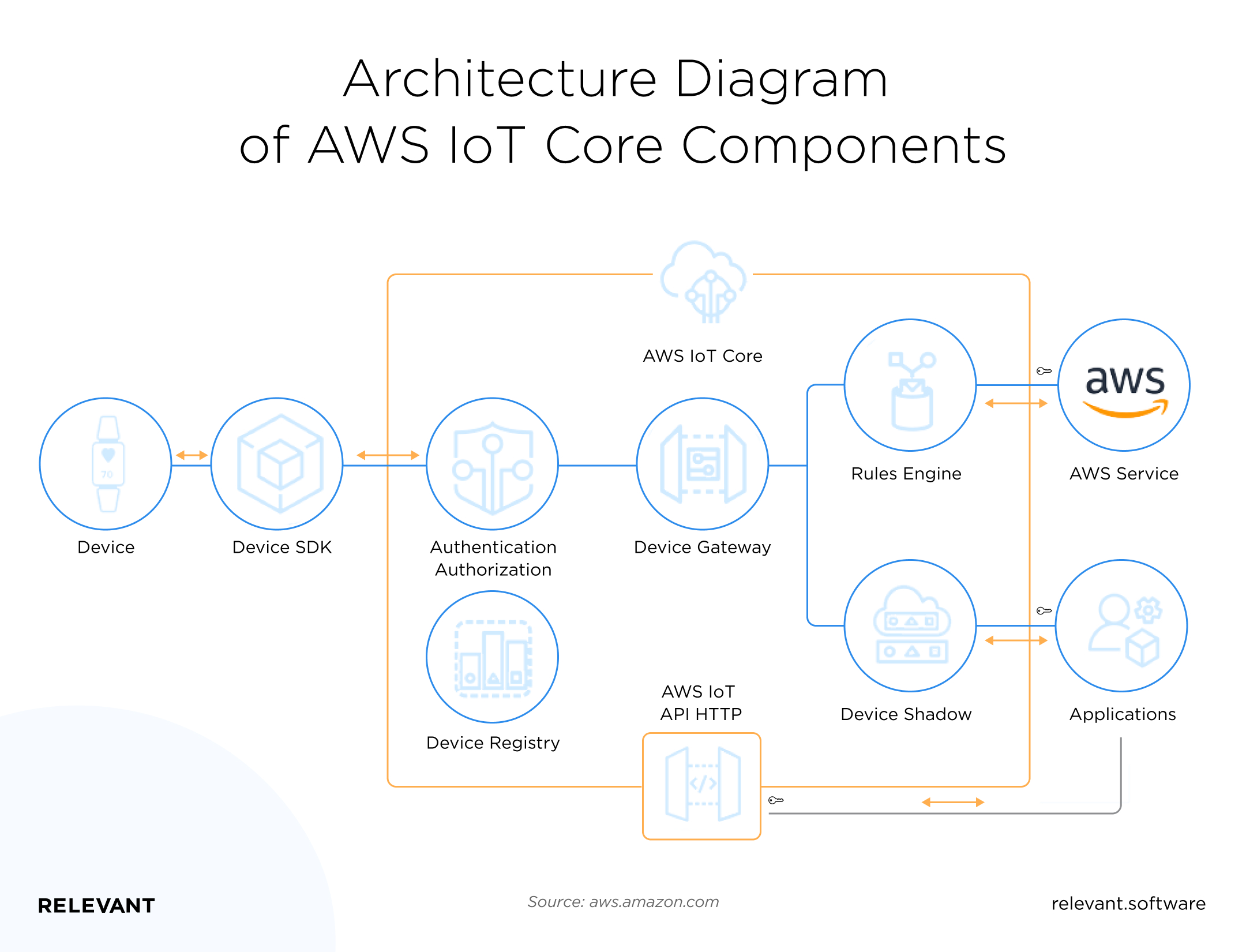
What are the features and capabilities of AWS IoT Core?
- Simple device management: AWS IoT Core can easily organize, manage, and remotely monitor IoT devices.
- Fast device connectivity: You can link devices by the AWS IoT Core Python SDK or utilize the AWS IoT core Arduino SDK. In short, if you want to launch an IoT device, the SDK option will be optimal for you.
- Secure data receiving: AWS IoT Core MQTT safely store millions of connected devices’ data records/messages.
- Multiple protocol support: AWS IoT gateway supports standard WebSockets, MQTT, and HTTP 1.1 protocols.
- Affordable code base management: AWS gives you complete low-code capabilities to run an IoT project from its inception to large-scale rollout.
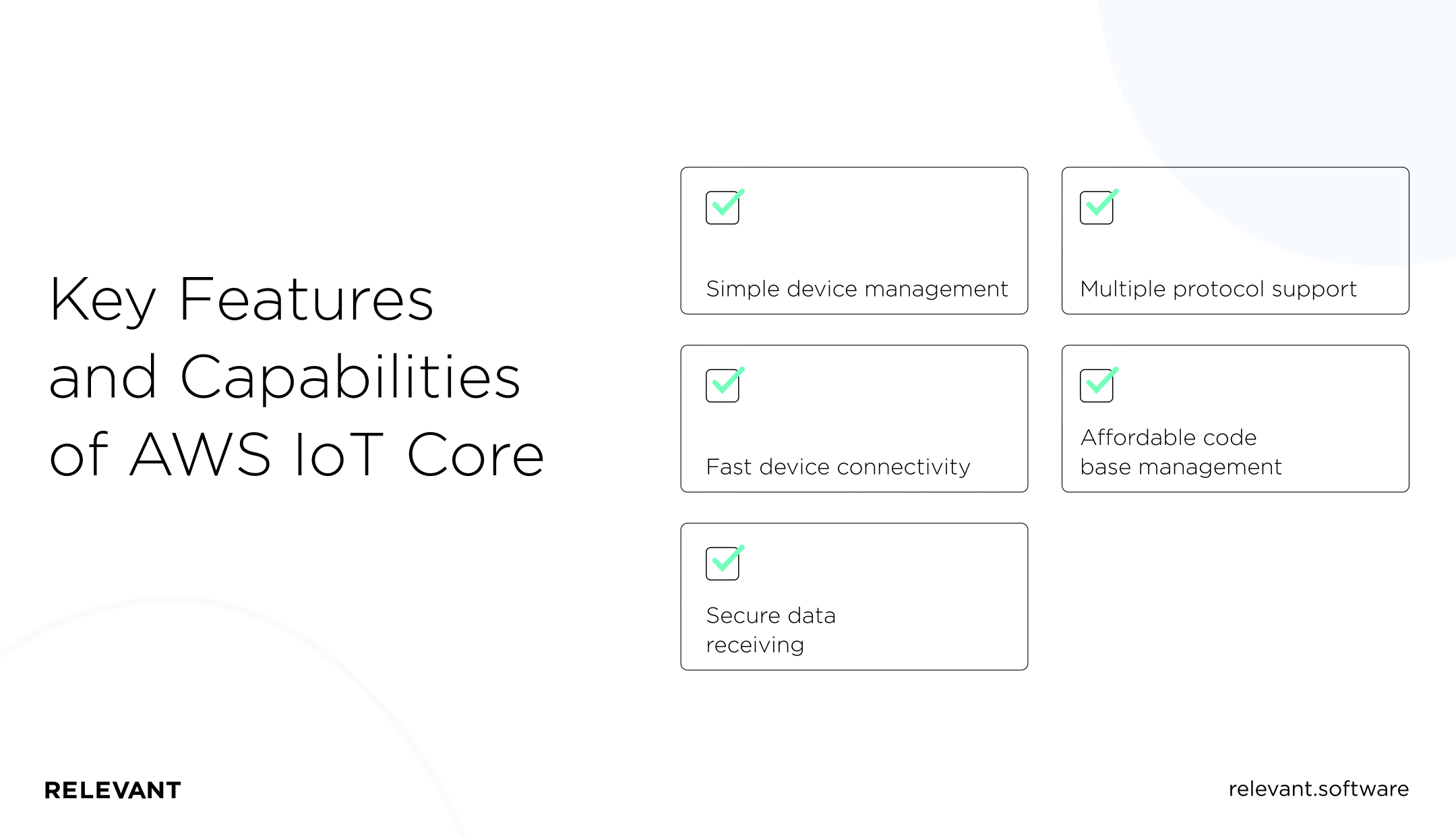
How to use AWS IoT Core
Before you start working with AWS IoT Services, you need to set up an AWS account. You can skip this stage if you already have an IAM and AWS account.
Register the devices
The first stage of utilizing AWS IoT Core is device registration. In AWS IoT Core, they are called things and can be either physical or logical. In the device registry, you assign your devices to objects in AWS IoT Core. You can register one or many devices at a time. To combine devices and apply the same command simultaneously, you can create groups in the IoT device registry.
Configure and provision devices
After registration, you need to prepare your device for use. To do this, you need three resources:
- IoT Thing
IoT Things are entries in the AWS IoT device registry. Each item has a unique name and set of attributes and is associated with a physical device. Things are identified by the type of thing or grouped into groups of things. - X.509 certificate
It is a digital certificate used to manage identity and security in Internet communications and computer networks. It provides the IoT Core device with the ability to authenticate and communicate with the thing. You can generate an X.509 AWS IoT core certificate or use an existing one. Then you will need to copy it. - IoT policy
For your device to communicate, you necessitate adding the IoT policy to the device certificate. This process will be quick if you only have one or more things provisioned into the IoT Core. But if there are many devices, AWS provides the ability to do this through Timely Registration (JITR) and Timely preparation (JITP). JITR enables you to set up a workflow that enrolls device certificates and automatically attaches IoT policies to them. JITP will create an IoT object and policy in AWS IoT and then attach them to things. Now your things can start working on the IoT Core!
Manage the devices
You can manage your items in the AWS IoT Core registry, where item information is stored as JSON data. AWS IoT Device Management grants you to perform batch updates, monitor deployment speed, set error thresholds, and define steady jobs to automatically update device software so that they always work with the latest version.
You can perform a device reboot and a factory reset to restore the machine to its original settings or fix security issues.
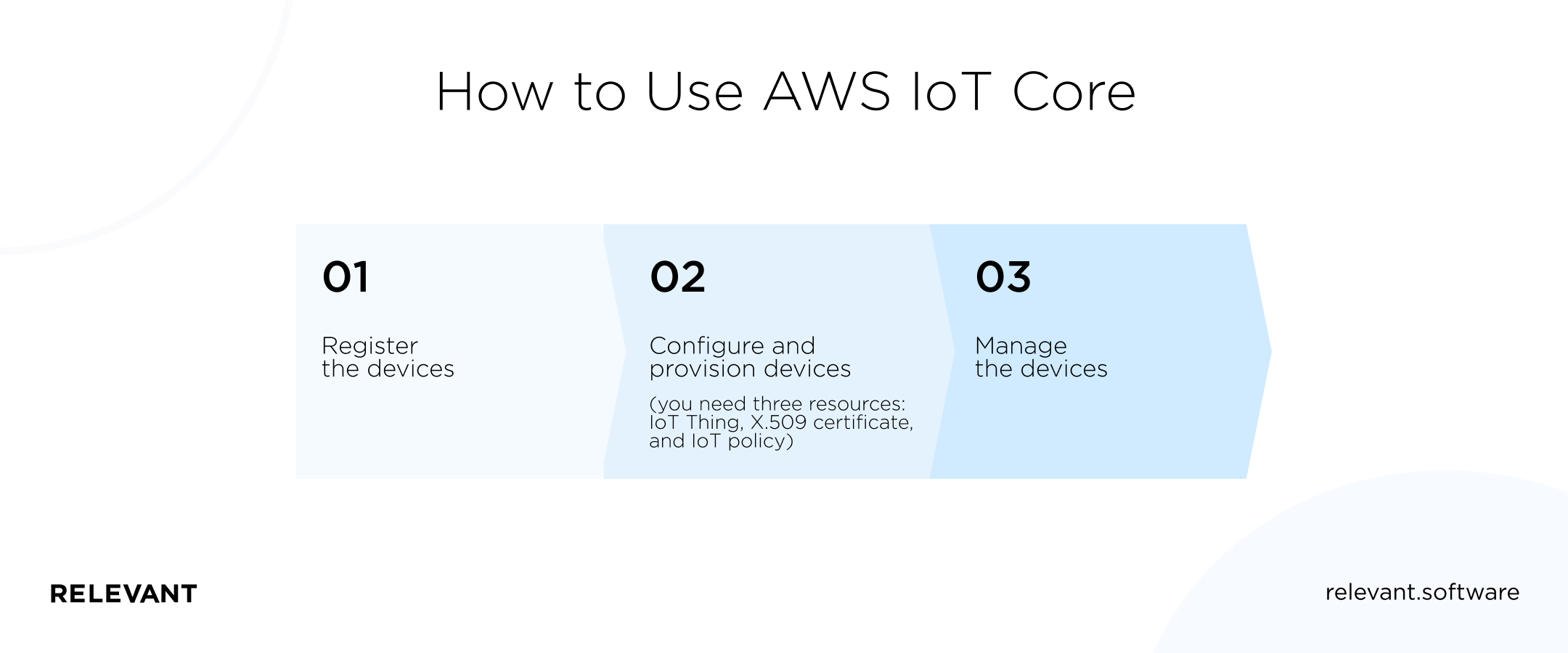
Device lifecycle in AWS IoT Core
- First, you need to enter the thing (for example, a lamp) into the register.
- The thing is then programmed to publish a set of values for its properties or states (On, Red) to the AWS IoT Core service.
- The last state information is stored in the shade of the thing.
- The lamp control app uses a RESTful API to query AWS IoT Core for the last passed lamp state.
- If the state changes (for example, the lamp turns off), the app uses the RESTful API to request an update, and the framework synchronizes the desired state with the thing.
- When the connected thing updates its state to the desired shape, the app is notified.
Hopefully, we’ve helped you understand how AWS IoT Core can be useful for your future deployments in our AWS IoT Developer Core Guide. For more information and the necessary AWS IoT documentation, please get in touch with us anytime.
Conclusion
As you can see, there is an excellent reason to hire software development team that prefers to work with AWS. Its impressive IoT infrastructure provides flexibility in terms of cost and choice among many valuable features. A pragmatic approach to security and stability is a decisive argument favoring AWS as an IoT platform provider.
As an experienced IoT software development company, Relevant leverages the power of AWS IoT Core to deliver scalable, secure, and reliable IoT solutions to our customers. Our applications provide a high level of data security, optimal resource management, seamless integration with various Amazon services, fast data processing, and reliable communication with connected devices.
Therefore, please let us know if you want to hire IoT developers with experience developing AWS IoT projects on Ukraine outsourcing or learn more about developing IoT solutions.
FAQ
Our core services:
Do you want a price estimate for your project?
Do you know that we helped 200+ companies build web/mobile apps and scale dev teams?
Let's talk about your engineering needs.
Write to us











